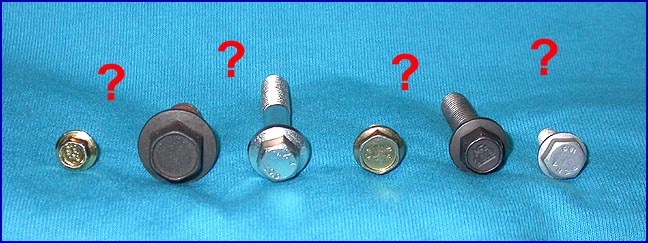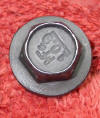|
Home
Factory Gage Installation
The 429 CJ Cougar Option
Ford Duraspark Distributor
Inspection Decals
Speedo Gears
429 Engine Detail
Identifying Platings
Rear Sway Bar
Valve Lash Mustang Central
| |
A Little Background On How This Page Came About
Our group recently developed a 429 CJ/SCJ Engine detailing
guide and one of the first things we found out was we didn't know
how to properly identify the coatings and platings used on the various
fasteners, pulleys and brackets. The job was further complicated because it
seems that each plating/coating can be referred to by multiple names! We asked
for some help from the Ford Fastener Engineering Lab as well as a local Plating
Shop to give us a lesson on identifying coatings and platings. Once we had all
this good information, we knew we had to make a special page to share it with
our fellow enthusiasts who may also find this information helpful for their
projects.
John Blair ~ 11/15/03
|
How to Identify Coatings and Platings on Underhood Parts
Parts |
|

Identifying the different types of coatings used on components can
be a tricky job, especially since both Zinc and Cadmium plating were used in
1971. An engineer from the Ford Fastener Engineering Laboratory has provided some "Rules of Thumb" to use in identifying coatings and platings.
These have been captured in the table below along with some photos of
these different coatings.
(Note: Click on thumbnail photos to enlarge)
| Coating |
Also Known As; |
How it Looks; |
| Zinc Chromate |
Zinc
Silver Zinc
Clear Chromate |
Shiny Silver
Plating
This shiny silver plating is commonly used on the new silver nuts and bolts you buy at the
hardware store and can sometimes have a slight bluish tint. Zinc plating
is the most common and economical type of plating and is a sacrificial
coating designed to corrode so the part does not. The limitations of
zinc are that when the plating begins to corrode the zinc rust is
plentiful and unsightly. Zinc Chromate plated bolts were used to
attach the fuel pump to the engine.



|
| Zinc Dichromate |
Yellow Zinc
Gold Zinc
Yellow Dichromate |
Yellow/Gold Shiny
Plating
This is a yellow/gold plating often seen with a pink and green rainbow
effect visible on the plating surface. Items with this coating are
first plated with zinc, then treated with a dichromate coating which
gives it the yellow/gold appearance. It provides moderate corrosion protection
and was used
on the 71 Alternator Pulley and Fan.



|
| Cadmium |
Silver Cadmium
Silver Cad
Clean Cadmium |
Dull to somewhat shiny Silver
Plating
Cadmium, a whitish, silvery
plating is superior to zinc for corrosion protection and is used in
harsh environments such as areas prone to salt corrosion, offering twice
the corrosion resistance of zinc. Although commonly used on fasteners
and other parts by Ford back in the 60s and early 70s, it is rarely used in
the auto industry today because of its toxicity. A good example
on our engines is the Accelerator Bracket and Valve Cover bolts.



 |
| Gold Cadmium |
Yellow Cadmium
Gold Cad
Yellow Cad |
Yellow/Gold Shiny
Plating
Like zinc dichromate,
this yellow/gold plating often has rainbow effect of pink and green visible in the plating. Items
with this coating are first plated with Cadmium, then treated with the
dichromate coating giving it the yellow/gold appearance. Like Silver
Cadmium, it was often used in areas subject to
corrosion from road salt since it has a
much higher resistance to corrosion than Zinc Dichromate. Cad is no longer used
on fasteners and underhood components by the automotive industry due to toxicity.
 |
| Zinc Phosphate |
Phosphate and Oil over Zinc |
Gray to Black Coating
This smooth, even, Gray to Black coating results from
phosphate and oil applied over a zinc base plating. Unlike the Phosphate
& Oil coating described next in this table, Zinc Phosphate does not have
the heavy phosphate crystallization present all over the fastener
surface. In addition, Zinc Phosphate maintains its original
appearance well and has much better corrosion resistance than "Phosphate
& Oil". This coating is frequently used for coil brackets, bolts,
and miscellaneous pieces where a nicer, dark appearance needs to be
maintained.



|
| Phosphate & Oil |
Phosphate and Oil over Manganese |
Gray Coating with
Crystals Evident
This
consistently Gray, dull coating is applied over a manganese base plating and
is characterized by a moderate to heavy phosphate crystallization over
the surface of the part. It is commonly used on fasteners and
some underhood components where appearance is not important (like
accessory drive brackets) since this
coating
deteriorates soon after its exposed to the
weather.
 

|
|
How To Tell One Plating From Another |
|
Okay, so now you know a bit more about the platings and coatings used
on the parts of your engine. But if you noticed in the chart above,
there are two silver coatings, two gold/yellow coatings and two
phosphate & oil coatings. How do you tell which is which? We asked a
plating company and the Ford Fastener Lab for some guidelines to help
with this.
|
|

How To Tell Silver Cadmium From
Zinc Chromate
Silver Cadmium plating tends to have a whiter
appearance and a duller luster than Zinc Chromate, which is more silvery
and shiny. In the photo above: Silver Cadmium on left, Zinc Chromate on
right.
|

How To Tell Zinc Dichromate From Gold Cadmium
This is an easy one - you can't !
That is, unless you take your part to a metallurgical lab and have it
tested on a special piece of equipment. These two coatings will appear
identical to the naked eye because although they have different base
platings (Cadmium -vs- Zinc), the final coating is the same type -
Dichromate. So, if you're going to re-plate an item you believe was
originally Gold Cad, why not go for the more easily available and less
toxic Zinc Dichromate? Oh yeah, I almost forgot - in the photo above,
that's Zinc Dichromate on the left and Gold Cadmium on the right ;-)
|

How To Tell Phosphate & Oil from Zinc Phosphate
These are both classified as "Phosphate and Oil"
type coatings. The difference lies in the coating applied before the
phosphate & oil overcoat. As the name implies, Zinc Phosphate is Zinc with a
Phos/oil coating applied while the "Phosphate and Oil" is actually
Manganese with a Phos/oil coating. Now, how to tell them apart. The
Zinc Phosphate coating (right, in photo above) will appear smooth and not have any obvious
crystallization in the coating and can vary from gray to black. The Phosphate &
Oil manganese based coating (left in photo above) will be consistently gray,
dull and will have
significant crystallization apparent in the coating. In the photo above,
note how the Phosphate & Oil manganese based coating at left has a very
heavy phosphate coating nearly obscuring the markings on the bolt head
while the Zinc Phosphate at right has a very smooth and even coating
showing the head markings clearly.
|
|
Hint
About Uncovering Your Original Coating
Many of the
original coatings can be found on parts in their "protected areas", where they
are fastened together to another part, underside of bolt heads, etc. These areas
have not been exposed to the elements and can usually provide a good indicator
of the part's original finish.
A
Special Warning About Cadmium Toxicity
All potential Cadmium platings should ONLY be removed by a
professional who knows about the material. Cadmium dust immediately leads to
respiratory infection, and even trace amounts can be extremely dangerous and
potentially fatal.
|
![]()
![]()